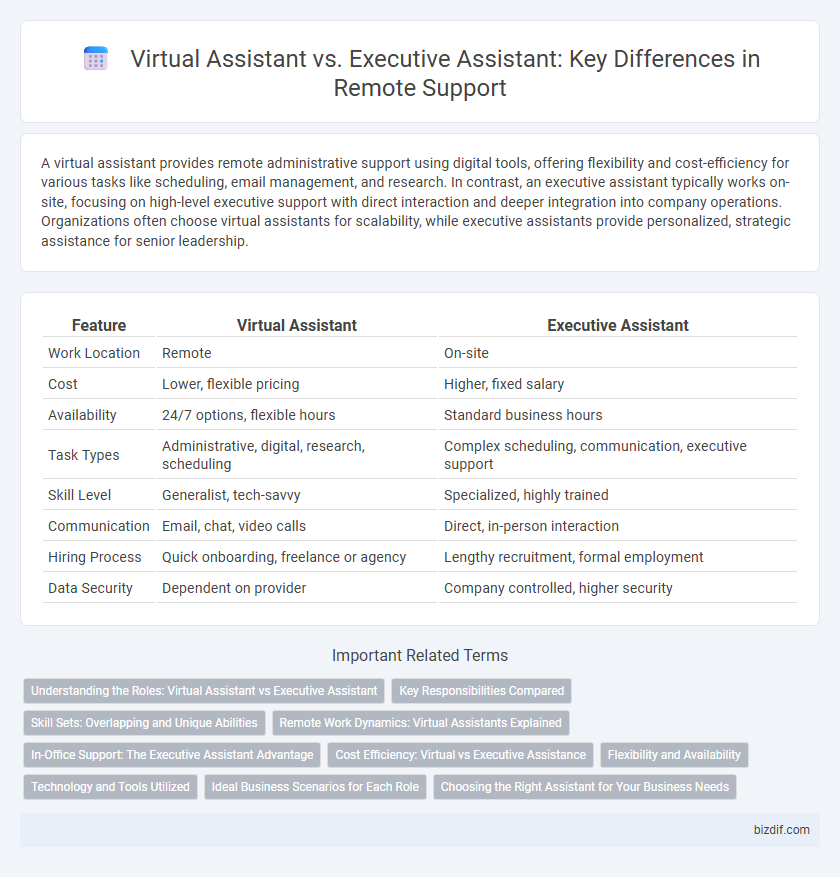A virtual assistant provides remote administrative support using digital tools, offering flexibility and cost-efficiency for various tasks like scheduling, email management, and research. In contrast, an executive assistant typically works on-site, focusing on high-level executive support with direct interaction and deeper integration into company operations. Organizations often choose virtual assistants for scalability, while executive assistants provide personalized, strategic assistance for senior leadership.
Table of Comparison
| Feature | Virtual Assistant | Executive Assistant |
|---|---|---|
| Work Location | Remote | On-site |
| Cost | Lower, flexible pricing | Higher, fixed salary |
| Availability | 24/7 options, flexible hours | Standard business hours |
| Task Types | Administrative, digital, research, scheduling | Complex scheduling, communication, executive support |
| Skill Level | Generalist, tech-savvy | Specialized, highly trained |
| Communication | Email, chat, video calls | Direct, in-person interaction |
| Hiring Process | Quick onboarding, freelance or agency | Lengthy recruitment, formal employment |
| Data Security | Dependent on provider | Company controlled, higher security |
Understanding the Roles: Virtual Assistant vs Executive Assistant
Virtual assistants provide remote administrative, technical, or creative support to multiple clients, offering flexible, task-specific services such as email management, scheduling, and social media handling. Executive assistants work onsite or remotely, delivering high-level, personalized support to C-suite executives by managing complex calendars, preparing reports, conducting research, and facilitating communication across departments. Understanding the distinct responsibilities and working environments of virtual assistants versus executive assistants helps organizations optimize workforce efficiency and tailor support based on specific executive needs.
Key Responsibilities Compared
Virtual assistants handle a broad range of remote tasks including email management, scheduling, customer support, and social media coordination, providing flexible support across multiple clients or projects. Executive assistants focus on high-level administrative duties such as preparing reports, managing executive calendars, coordinating meetings, and acting as a liaison between executives and stakeholders. The key difference lies in the scope and setting, with virtual assistants offering diverse, tech-driven assistance remotely, while executive assistants provide dedicated, in-person support tailored to top executives.
Skill Sets: Overlapping and Unique Abilities
Virtual assistants excel in digital communication, time management software, and multitasking across various remote platforms, while executive assistants uniquely master in-person coordination, high-level project management, and confidential communication with executives. Both roles require strong organizational skills, attention to detail, and the ability to prioritize tasks efficiently, but virtual assistants often need advanced tech proficiency and adaptability to various client-specific tools. Executive assistants typically possess deep industry knowledge and hands-on experience in managing corporate calendars, travel logistics, and face-to-face stakeholder interactions.
Remote Work Dynamics: Virtual Assistants Explained
Virtual assistants operate remotely, leveraging digital tools to manage tasks without geographical constraints, enhancing flexibility in dynamic work environments. Executive assistants typically work on-site, providing personalized and immediate support to executives within traditional office settings. Remote work dynamics favor virtual assistants by enabling seamless communication, scheduling, and project management across time zones, optimizing efficiency for dispersed teams.
In-Office Support: The Executive Assistant Advantage
Executive assistants provide comprehensive in-office support, managing scheduling, correspondence, and logistics with a hands-on presence that virtual assistants cannot replicate. Their physical availability enables real-time problem-solving and immediate coordination during meetings and events. This direct interaction fosters stronger workplace relationships and enhances operational efficiency within the office environment.
Cost Efficiency: Virtual vs Executive Assistance
Virtual assistants typically offer greater cost efficiency compared to executive assistants due to lower overhead expenses such as office space, equipment, and benefits. Businesses save money by paying virtual assistants on an as-needed or hourly basis, avoiding the fixed costs of salaried executive assistants. This flexible staffing model allows companies to scale support according to workload, maximizing budget optimization.
Flexibility and Availability
Virtual assistants offer greater flexibility and availability compared to executive assistants due to remote work capabilities and diverse task management across different time zones. Executive assistants typically work traditional office hours and are physically present, providing immediate support but with limited scheduling flexibility. Virtual assistants can adapt to varying client needs and extended hours, making them ideal for businesses requiring round-the-clock assistance.
Technology and Tools Utilized
Virtual assistants leverage cloud-based software, project management tools like Asana and Trello, and communication platforms such as Slack and Zoom to operate efficiently from remote locations. Executive assistants typically utilize advanced office suites, calendar management software like Microsoft Outlook, and in-person collaboration tools to support high-level executives within corporate environments. Both roles depend heavily on technology, but virtual assistants prioritize digital solutions that enable flexibility and remote access, while executive assistants focus on integrated, office-centric applications for seamless executive support.
Ideal Business Scenarios for Each Role
Virtual assistants excel in remote support for startups and small businesses seeking cost-effective, flexible administrative help without on-site presence. Executive assistants are ideal for executives requiring dedicated, high-touch support, managing complex schedules and confidential tasks within corporate environments. Businesses with dynamic, in-person needs benefit from executive assistants, while virtual assistants suit those valuing scalable, task-specific assistance.
Choosing the Right Assistant for Your Business Needs
Virtual assistants offer flexibility and cost-efficiency by handling remote administrative, technical, or creative tasks, making them ideal for startups and small businesses with variable workloads. Executive assistants provide dedicated, in-person support tailored to high-level executives, managing schedules, communications, and complex projects with a deep understanding of company dynamics. Businesses should evaluate workload intensity, budget constraints, and the need for physical presence when choosing between a virtual or executive assistant to maximize productivity and resource allocation.
Virtual assistant vs Executive assistant Infographic

 bizdif.com
bizdif.com